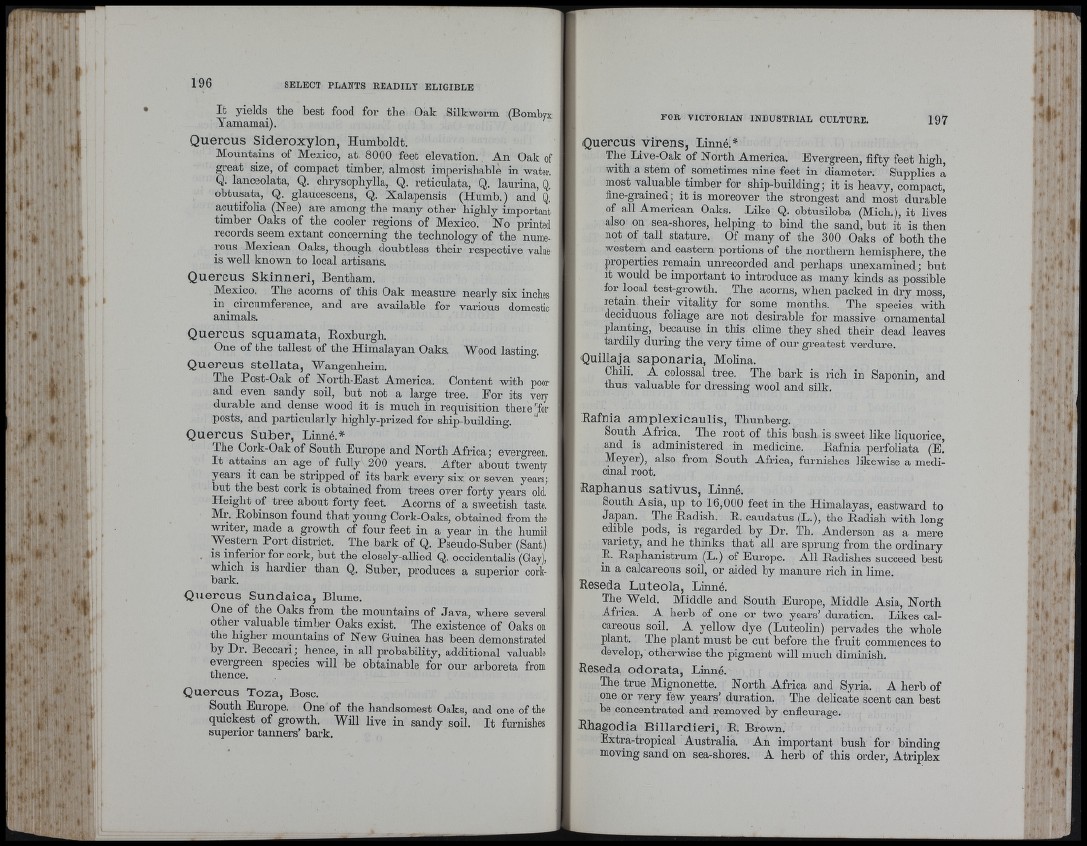
' u t- ï
• ‘■■t-
I
M'
M
if'l
' ♦ «î "1
t ■
I t yields tlie best food for the Oak Silkworm (Bombyx
Yamamai).
Quercus Sideroxylon, Humboldt.
Mountains of Mexico, at 8000 feet elevation. An Oak of
great size, of compact timber, almost imperishable in water,
Q. lanceolata, Q. cbrysophylla, Q. reticulata, Q. laurina, Q,
obtusata, Q. glaucescens, Q. Xalapensis (Humb.) and Q,
acutifolia (Nee) are among the many other highly important
timber Oaks of the cooler regions of Mexico. No printed
records seem extant concerning the technology of the numerous
Mexican Oaks, though doubtless their respective value
is well known to local artisans.
Quercus Skinneri, Bentham.
Mexico. The acorns of this Oak measure nearly six inches
in circumference, and are available for various domestic
animals.
Quercus squamata, Roxburgh.
One of the tallest of the Himalayan Oaks. Wood lasting.
Quercus stellata, Wangenheim.
The Post-Oak of North-East America. Content with poor
and even sandy soil, but not a large tree. For its very
durable and dense wood it is much in requisition there Tor
posts, and particularly highly-prized for ship-building.
Quercus Suber, Linné.*
The Cork-Oak of South Europe and North Africa; evergreen,
I t attains an age of fully 200 years. After about twenty
years it can be stripped of its bark every six or seven years;
but the best cork is obtained from trees over forty years old.
Height of tree about forty feet. Acorns of a sweetish taste.
Mr. Robinson found th a t young Cork-Oaks, obtained from the
writer, made a growth of four feet in a year in the humid
Western Port district. The bark of Q. Pseudo-Suber (Sant.)
, IS inferior for cork, but the closely-allied Q. occidentalis (Gay),
which is hardier than Q. Suber, produces a superior cork-
bark.
Quercus Sundaica, Blume.
One of the Oaks from the mountains of Java, where several
other valuable timber Oaks exist. The existence of Oaks on
the higher mountains of Hew Guinea has been demonstrated
by Dr. Beccari; hence, in all probability, additional valuable
evergreen species will be obtainable for our arboreta from
thence.
Quercus Toza, Bose.
South Europe. One of the handsomest Oaks, and one of the
quickest of growth. Will live in sandy soil. I t furnishes
superior tanners’ bark.
FOR VICTORIAN INDUSTRIAL CULTURE. 197
Quercus virens, Linné.*
The Live-Oak of North America. Evergreen, fifty feet high,
with a stem of sometimes nine feet in diameter. Supplies a
most valuable timber for ship-building; it is heavy, compact,
fine-grained; it is moreover the strongest and most durable
of all American Oaks. Like Q. obtnsiloba (Midi.), it lives
also on sea-sbores, helping to bind the sand, but it is then
not of tall stature. Of many of the 300 Oaks of both the
western and eastern portions of the northern hemisphere, the
properties remain unrecorded and perhaps iinexamined; hut
it would be important to introduce as many kinds as possible
for local test-growtb. The acorns, when packed in dry moss,
retain their vitality for some months. The species with
deciduous foliage are not desirable for massive ornamental
planting, because in this clime they shed their dead leaves
tardily during the very time of our greatest verdure.
Quillaja saponaria, Molina.
Chili. A colossal tree. The bark is rich in Saponin, and
thus valuable for dressing wool and silk.
Rafnia amplexicaulis, Thunberg.
South Africa. Tbe root of this hush is sweet like liquorice,
and is administered in medicine, Eafnia perfoliata (e !
Meyer), also from South Africa, furnishes likewise a medicinal
root,
Raphanus sativus, Linné.
South Asia, up to 16,000 feet in the Himalayas, eastward to
Japan. The Radish. R. candatus (L.), the Radish with long
edible pods, is regarded by Dr. Th. Anderson as a mere
variety, and lie thinks th a t all are sprung from the ordinary
R. Raphanistrum^ (L.) of Europe. All Radishes succeed best
in a calcareous soil, or aided by manure rich in lime.
Reseda Luteola, Linné.
The Weld. Middle and South Europe, Middle Asia, North
Africa. A herb of one or two years’ duration. Likes calcareous
soil. A yellow dye (Lnteolin) pervades the whole
plant. The plant must be cut before the fruit commences to
develop, otherwise the pigment will much diminish.
Reseda odorata, Linné.
The true Mignonette. North Africa and Syria. A herb of
one or very few years’ duration. The delicate scent can best
be concentrated and removed by enfieurage.
Rhagodia Billardieri, R. Brown.
Extra-tropical Australia. An important bush for binding
moving sand on sea-shores. A herb of tbis order, Atriplex
¡
i ‘
4
■I '
éf , '-I
I't’- 1.
I
-, 'rtr
I. ' ' ' I v:
«r u .-rt '
r
y ' ,
t ' ' '